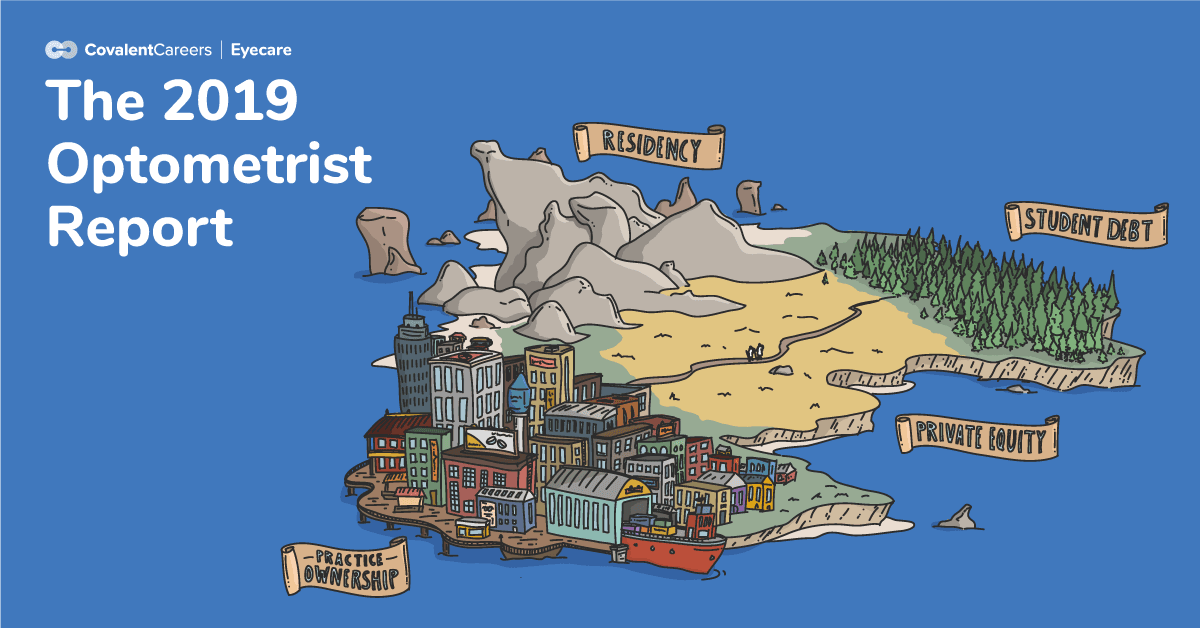The optometry industry is changing quickly, with private equity, salary negotiations, and non-clinical careers looming large over the landscape. How can you, as a student, practicing OD, or practice owner, navigate this turbulent terrain and complete your epic quest for work/life balance, career growth, and compassionate patient care?
JUST RELEASED
See how over 300 optometrists are navigating optometry in 2023, from salary expectations to future innovations in the 2023 Optometrist Report. Reveal findings >>
CovalentCareers conducted a survey of 1,181 optometrists to answer those questions. We asked about basic facts like gender, graduation year, and salaries, and more obscure topics like confidence in managing finances, impressions of private equity, and feelings about the future of the profession.
In this report, we’re sharing our findings with anyone looking to hire optometrists and with optometrists looking to get a better understanding of the state of the industry and the path they’re carving through the profession. Every epic story needs a wise mentor, and, for this stretch of your journey, we’re nominating ourselves for that position.
In the 2019 Optometrist Report, we cover:
- Optometrist salaries – Expected starting salaries; current optometry salaries by setting, gender, and grad year
- Optometrist hiring – Employer branding and recruitment marketing, the difficulty in hiring ODs, and considerations for optometry jobs
- Optometrist employment – Top settings and clinical foci for optometrists
- Finances – Optometry student loans, taxes, and confidence in managing finances
- The Future – Optometrists’ feelings about the challenges facing the profession and what they think about the future
- And more!

Download the 2019 Optometrist Report
Get access to the full report with over 50 charts and graphs!

Our brave protagonists: who we surveyed
Out of the 1,181 eyecare professionals we surveyed, 798 were optometrists, 292 were optometry students, and 91 were practice owners. Of all survey respondents, 73.2% were female. While this percentage is higher than the gender composition of the optometrist workforce in the United States (which is 50.4% male, according to US Census data), it is close to the current enrollment by gender at optometry school, which the 2018 ASCO Student Data Report identified as 67.8% female.
In terms of where ODs work, private practice was the most represented practice setting; however, fewer optometry students end up in private practice than hope to work in that setting. Whether that’s due to limited positions, residency opportunities, or competitive employment packages from corporate practices is unclear.
Quest rewards: optometrist starting salaries are on the rise
Despite the cliché that young people these days are entitled, the optometry students we surveyed expect similar starting salaries to what practicing optometrists received.
When it came to settings, we saw more optometrists heading towards corporate practice—and when we looked at salary differences between private and corporate ODs, we could understand why.
However, we also found a stark difference between the median salary of female and male ODs. (This difference roughly equaled that between one other group—make sure to download the full report to see!)
Menacing ogres: optometry student debt looms large
The average student loan debt for optometrists is $134,199—from the just-out-of-school high of $173k to the 17-years-and-we’re-about-to-pay-it-off low of $12.7k.
The difference in average student loan debt between optometrists who did a residency and optometrists who went straight into practice was roughly $20,000—but optometry students, don’t let this dissuade you from residency. 95.9% of optometrists who did a residency said it was worth it. In addition, ODs who did a residency reported paying off their debt at a faster rate than ODs who did not pursue residency.
Choosing your travel companions: on optometrist hiring trends
What is unfortunately all too clear is the disconnect between what optometry practice owners believe candidates value and what candidates actually value. When asked what aspect of an employer’s brand they thought was most important, 95.1% indicated that they consider an employer’s brand when applying to jobs. Meanwhile, practice owners are finding it overwhelmingly difficult to attract applicants to their practice—but most of them are spending nothing on branding or recruitment marketing, and on average rank the importance of their employer brand at less than 6 out of 10.
With a 9,000 FTE shortage of optometrists, these numbers will have to change, or hiring will only get more difficult for practice owners.
Boss battle: the future of optometry
Even with student debt, the threat of private equity, and other challenges to the profession, optometrists remain cautiously optimistic. These are trials to overcome, rivals with whom to build alliances, and all of these challenges are surmountable with the companions and mentors optometrists meet along the way—whether through formal organizations like AOA or outside of that structure.
In the end, over three-quarters of optometrists said that if given the choice to do it all over again, they’d still choose optometry. Still, that’s almost 25% who would choose another path—does this have to do with the extraordinarily high number of optometrists interested in non-clinical practice?
The Bureau of Labor Statistics reports a substantially higher job growth in optometry than the national average, and as the US population ages, more optometrists will be needed to manage age-related diagnoses.
At CovalentCareers, our primary goal is to provide job placements, mentorship, and hiring assistance to healthcare practitioners. With this report, we hope to start a conversation and spread understanding about the industry-wide trends that are shaking up the hiring outlook for optometry practices across the United States.
